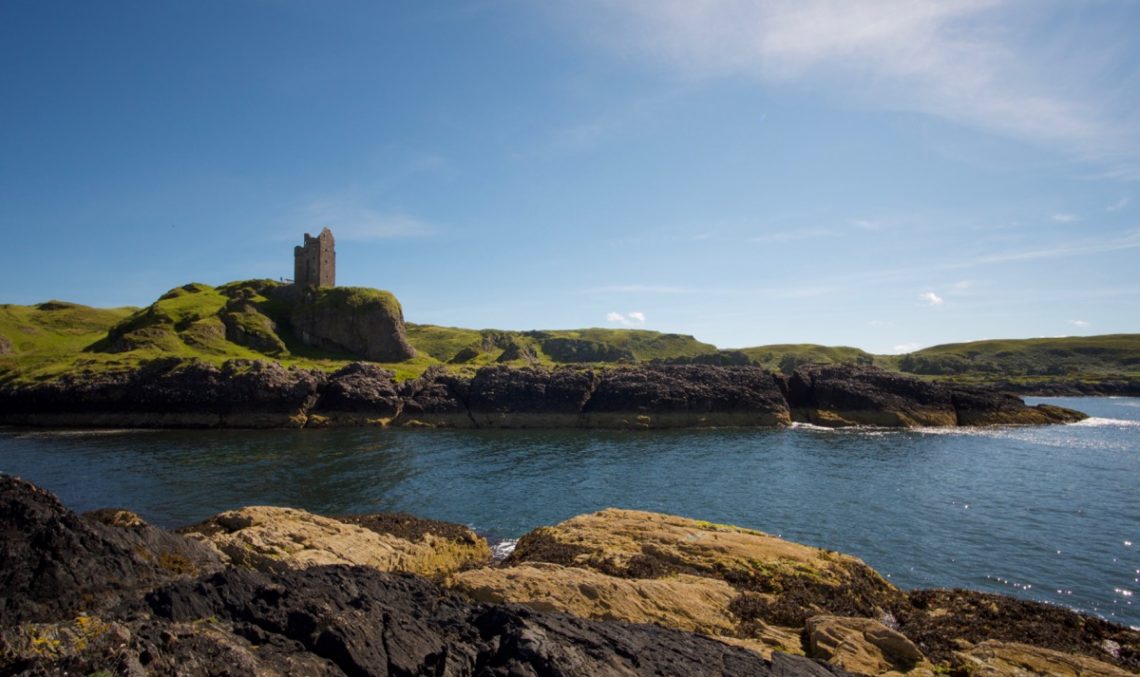
Gylen Castle and the Brooch of Lorn
Gylen Castle sits at the southern tip of the island of Kerrera, on a promontory overlooking the Firth of Lorn. We’ve seen it often from the sea, but never had a chance to walk there until last summer, when we took the ferry over to the island and followed the path that loops around the lower end, making a circuit of about seven miles.
At first the path hugged the coast, skirting Horseshoe Bay where green fields run down to a seaweedy beach. (It was here, in 1249, that King Alexander II came ashore from his galley and died of a sudden and mysterious illness while his fleet waited in Oban Bay; this story is told in my post about Kilchattan chapel on Luing.) Then we headed inland for a stretch, across low hills and farmland, before striking back towards the sea. The castle rose into view beyond a waving expanse of bracken and fields of grass, close-cropped by sheep; it’s a ruin, of course, but the statement of power is still there.
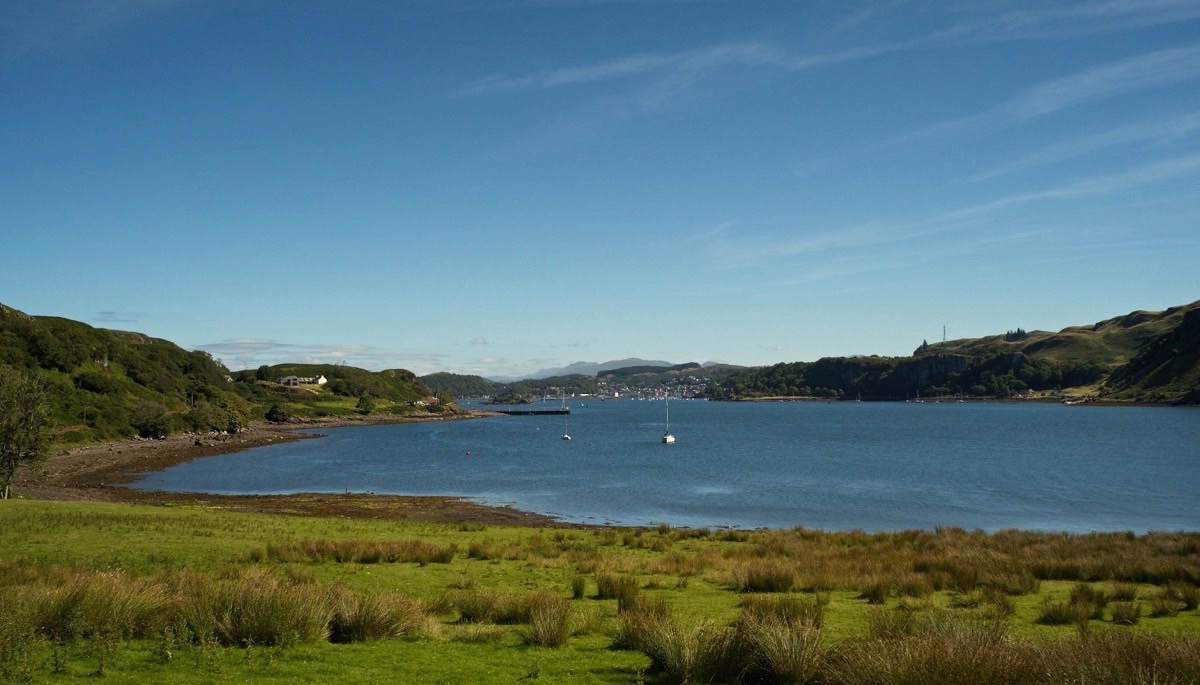
Horseshoe Bay
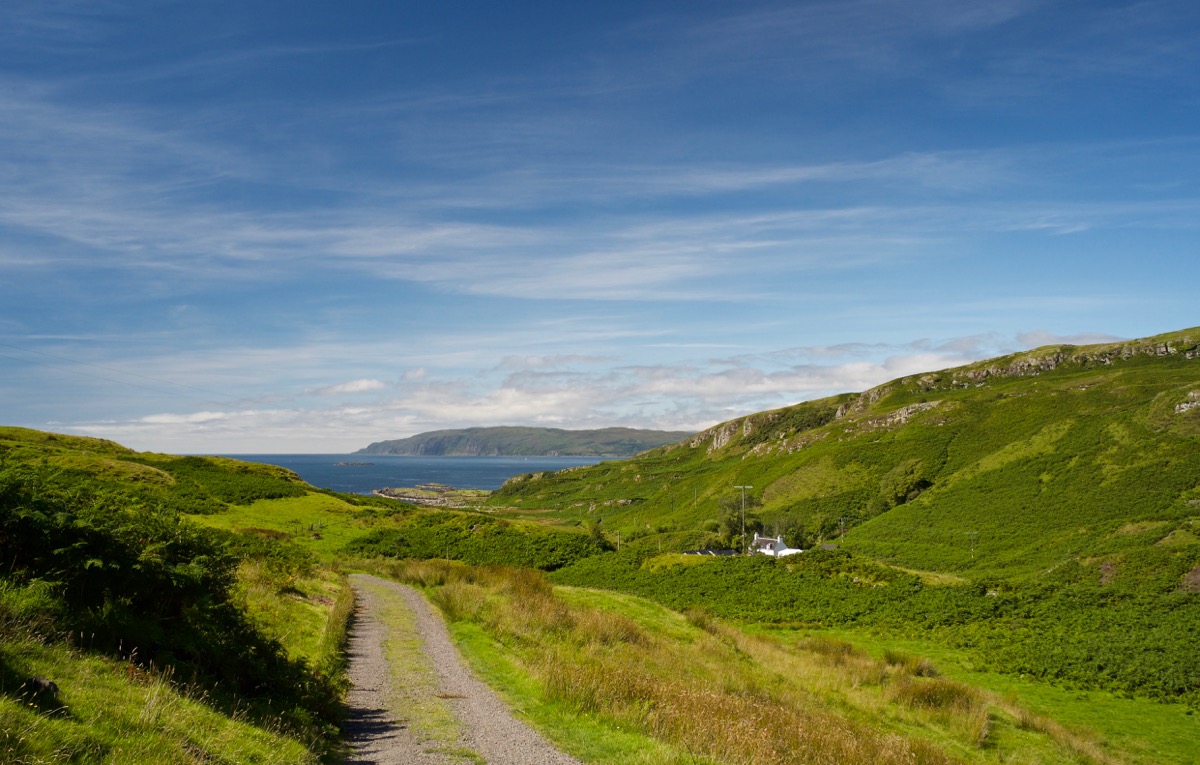
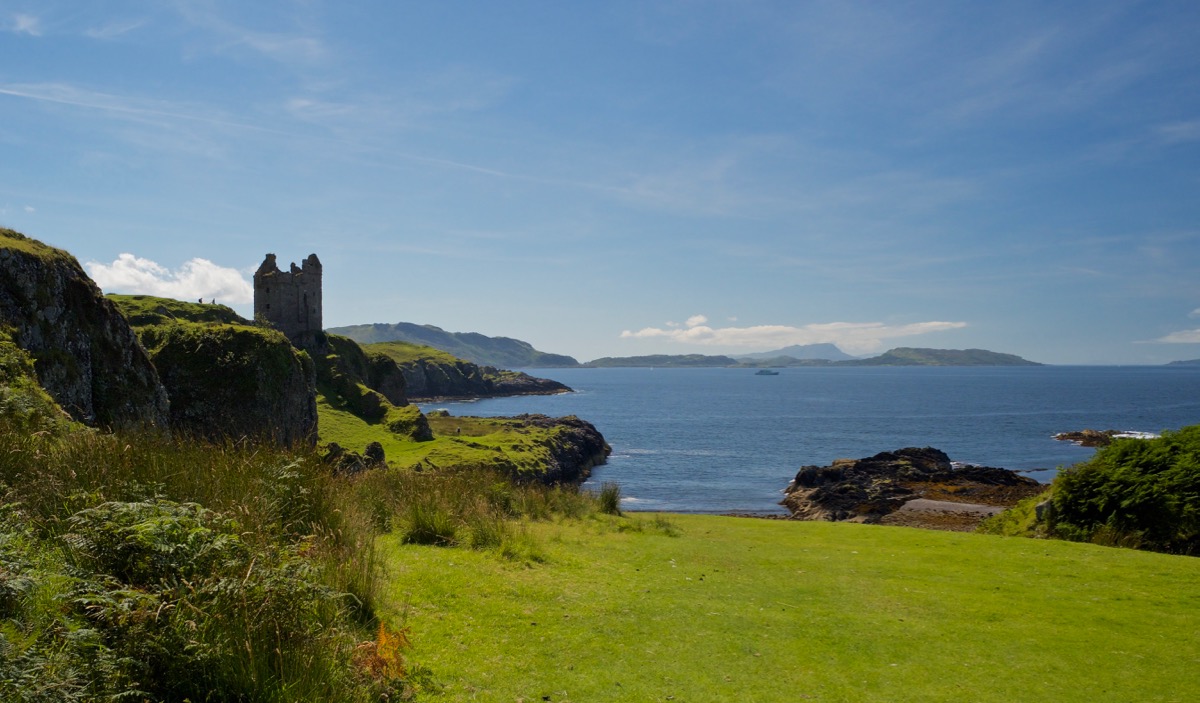
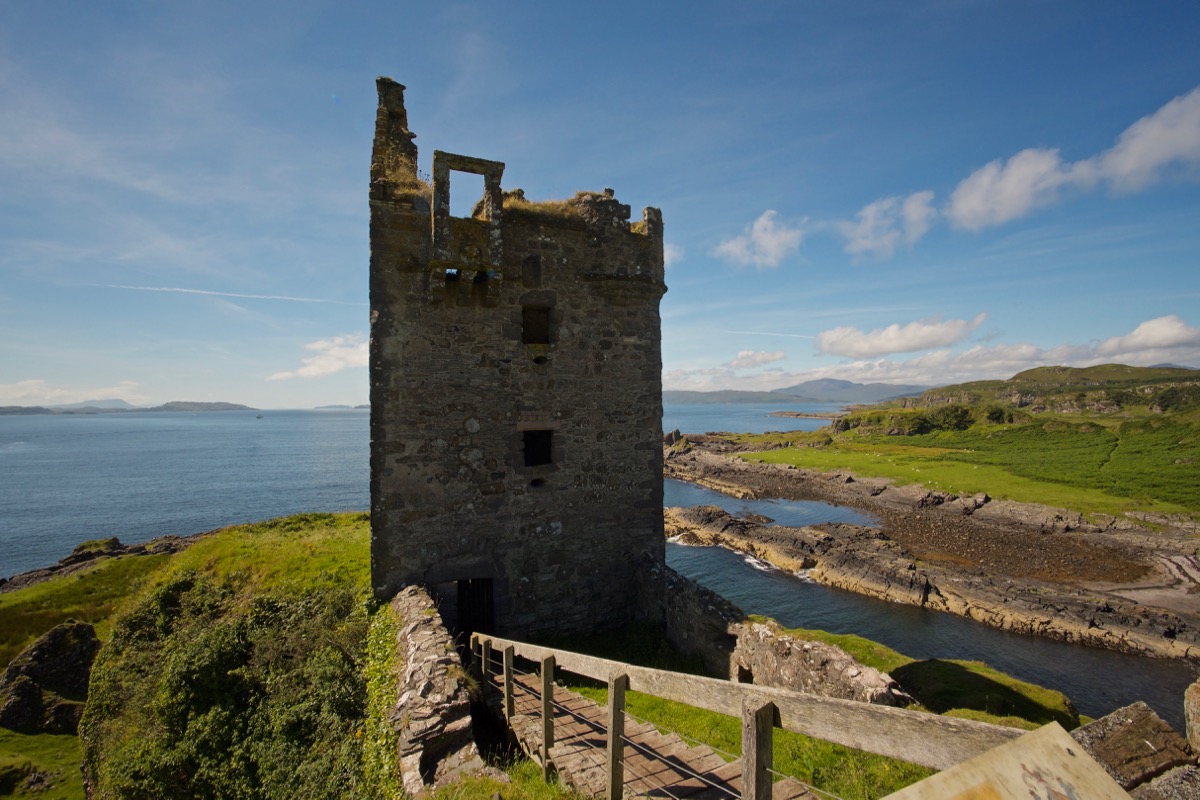
This is a traditional tower house, tall and rectangular in plan, and it was built by Duncan MacDougall of Dunollie, the 16th MacDougall Chief, in 1582. Its name comes from the Gaelic Caisteal nan Geimhlean or ‘castle of the fountains’, referring to the freshwater springs that flow close by. There was a single room on each of its four main floors, and two turrets were set into the slate roof; one of these enclosed a spiral staircase to the topmost room or ‘cap house’.
The castle was deliberately positioned so that it was hard to access, and if you’re approaching from the west it’s still a bit of a scramble up a slippery grass slope before you arrive outside the main entrance. The area immediately in front, known as the ‘forework’, now drops away to the shore on both sides, but once it would have been enclosed by a protective wall with holes through which muskets could be fired at unwelcome visitors beaching their boats in one of the bays below.
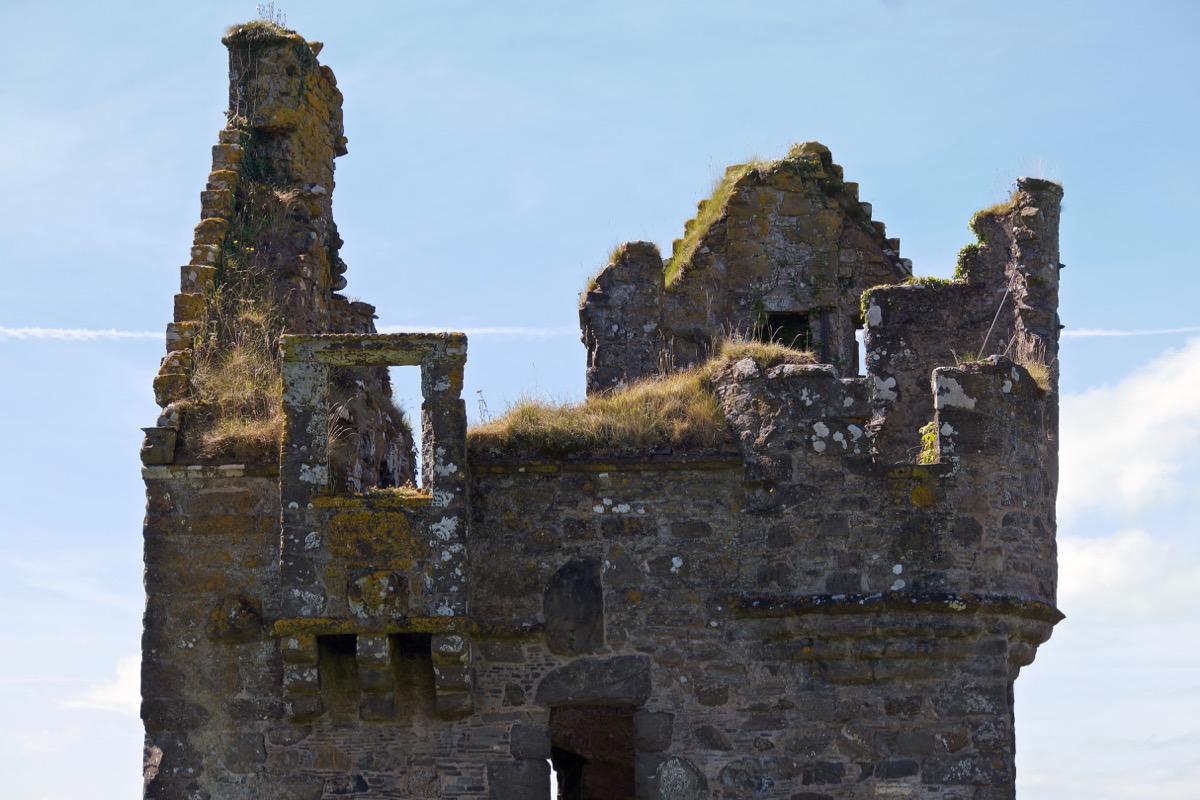
The oriel window
This was a high-status building, embellished with ornate carvings and expensive details. On the third floor, an elaborate oriel window projects over the main entrance, and an information sign at the site reveals that this feature is unique in the surviving architecture of the West Highlands. Inscribed on a stone panel beneath the window, now seriously weathered and obscured by lichen, are some words which have been deciphered as:
TRUST IN THY GOD
AND IN NOT MEN
MY SON DO WELL
AND LET THEM SAY
Beneath the inscription is carved the head of a woman with long hair, and to one side is the bust of a man wearing a ruff and pleated skullcap. Other carved figures have been interpreted as a kneeling man and an angel. All these details are almost impossible to make out now, but a drawing published on Canmore’s website shows their locations. A date stone (now removed) bore the year 1582, along with some initials that may have referred to the builder, Duncan MacDougall.
Apparently, the window was practical as well as decorative: the floor could be removed so that stones or boiling water could be poured on the heads of would-be intruders standing directly below. It sounds extreme, but the occupants of Gylen were right to be anxious about unwanted callers.
Artist’s impression of the north side, showing the main entrance with oriel window and turret above (from an on-site information board)
In 1647, when the Civil War pitted Royalists against Covenanters, Gylen Castle was occupied by a garrison of MacDougalls who were loyal to the crown. Outside the walls was an army of Covenanters, headed by the experienced military leader, General David Leslie. The castle was too well defended for them to attack, so they laid siege to it; although the Royalist garrison had food supplies, it is believed that they ran out of water, possibly because a lack of rain caused the springs to run dry.
Having been promised leniency if they gave themselves up, the MacDougalls surrendered – but, according to tradition, all were massacred, with the exception of John MacDougall, the 19th Chief, who was just a boy. Then the castle was ransacked and set ablaze. Only 65 years after it was built, Gylen Castle became a charred and smoking shell, and it has remained in ruins ever since.
Inside the castle, none of the floors have survived although the remnants of spiral staircases can still be seen.
An extraordinary relic that was seized from the castle by the attackers was the Brooch of Lorn. To the MacDougalls, this beautiful item of jewellery held almost mythical status, and ironically it had been moved to Gylen from another MacDougall stronghold, Dunollie Castle, for safe keeping.
The brooch is said to have fallen – quite literally – into the MacDougalls’ hands in 1306. Robert the Bruce was fleeing westwards with a number of followers after their defeat at the Battle of Methven, but they were stopped in Strathfillan by a large party of MacDougalls who had supported John Comyn, a rival contender for the crown of Scotland whom Bruce had murdered a few months earlier.
Bruce engaged the MacDougalls in battle at a place later known as Dail Righ or Dalrigh (‘the king’s field’). Seeing that he was heavily outnumbered, Bruce spurred his horse and galloped away. As he entered a narrow pass, he was attacked by three MacDougall clansmen, one of whom grabbed at his cloak to unseat him. But Bruce broke away, leaving his opponent holding the cloak and the brooch which had pinned it around his shoulders.
Circular in shape, about four and a half inches (11.4 cm) in diameter, and crafted from silver, the Brooch of Lorn is a fascinating work of art. In the centre, a clear quartz cabochon or ‘charm-stone’ forms the lid of a tiny round casket which, so it is said, once contained a fragment of a saint’s bone and a faded piece of MacDougall tartan. Around the edge are set eight small silver ’turrets’, each topped with a Scottish freshwater pearl. (I love how even the brooch is turreted!)
Sir Walter Scott, never one to knowingly ignore a good story, immortalised the Brooch of Lorn in his poem, The Lord of the Isles (1815):
‘Whence the broach of burning gold,
That clasps the Chieftain’s mantle fold,
Wrought and chased with rare device,
Studded fair with gems of price…’
With the fall of Gylen Castle, the brooch was lost for 150 years and only re-surfaced in the early 1800s: after the death of Major Campbell of Bragleen, it was found at the bottom of one of his chests, with a document confirming its authenticity. In 1824 it was officially returned to the MacDougalls.
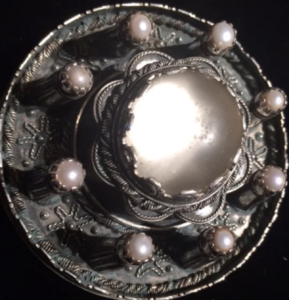
The Brooch of Lorn is in the ownership of the MacDougall of Dunollie Preservation Trust, and is currently housed in the National Museum of Scotland. An exact replica is on display in the 1745 House Museum at Dunollie Castle. Photo courtesy The MacDougall of Dunollie Preservation Trust www.dunollie.org
I have to add a cautionary note, however. Historians who have studied the style and construction of the brooch now believe that it cannot be from the time of Bruce, but is more likely to date from the 15th or 16th century. (Two similar brooches, the Ugadale Brooch and the Lochbuie Brooch, are considered to originate from this period). One theory suggests that the quartz charm-stone may be from an older setting, and could possibly have adorned an earlier brooch – conceivably, one that was worn by Bruce. The National Museum’s website says that ‘it is possible that… a 14th-century brooch was refashioned in subsequent centuries.’
Charm-stones, usually of clear, naturally-occurring quartz, were prized artefacts in Highland lore, because they were believed to have powers of protection and healing. (I guess this explains why so many of us still pick quartz pebbles up off the beach!)
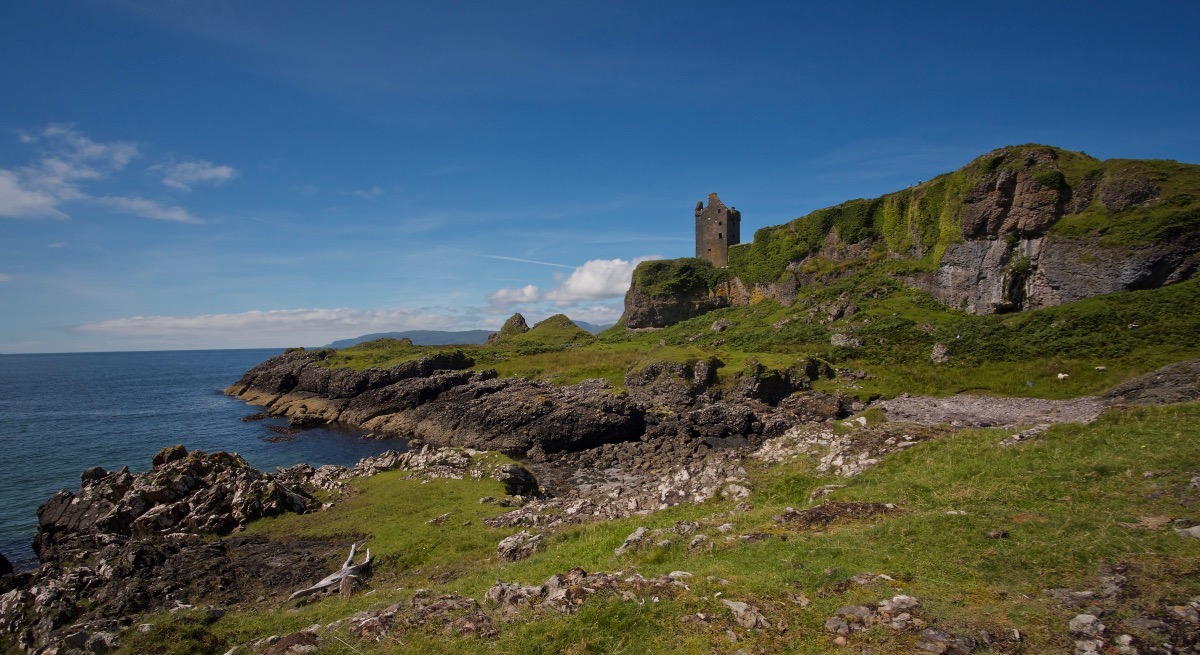
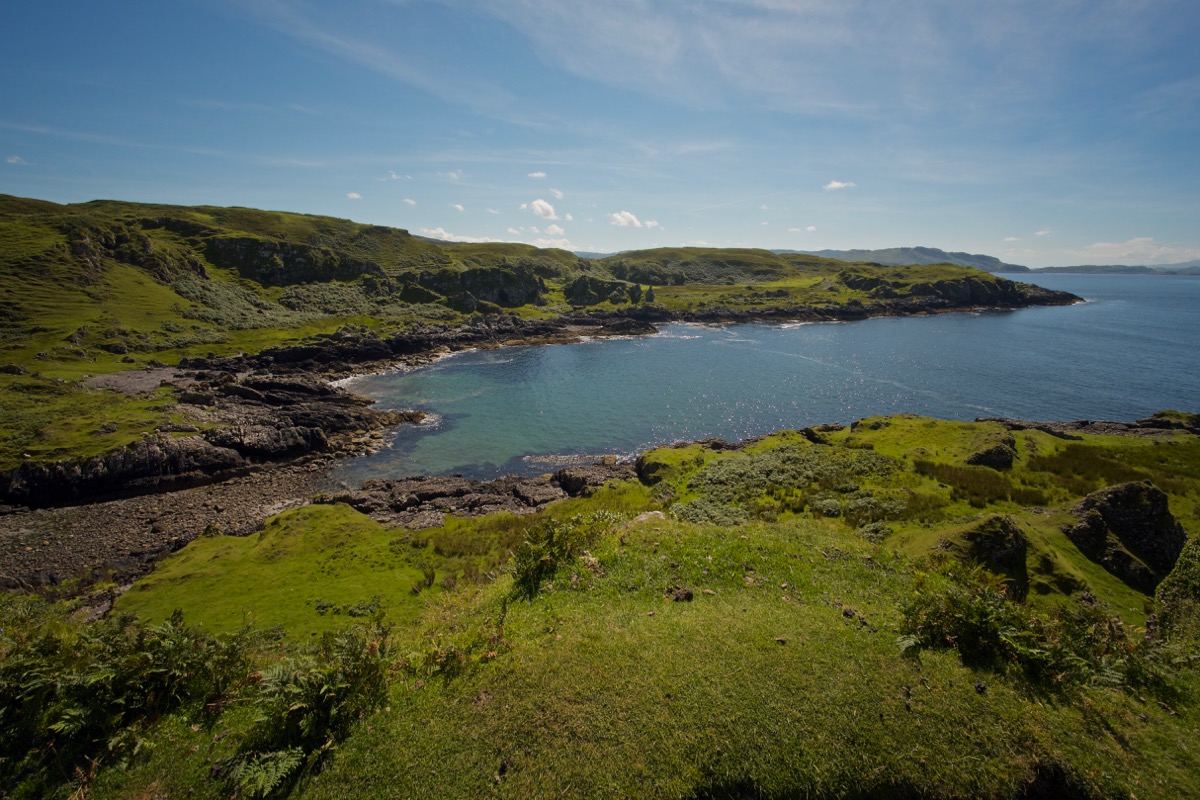
As the heat of the day increased, we followed the track that meanders around the southern end and then turns northwards, before cutting across the hills and back to the east coast. Here and there, the remains of old stone cottages showed that the island was once more populated than it is now; in former centuries, Kerrera was a kind of stepping-stone for both people and cattle travelling from the outer islands.
The views were shimmering and immense, with white-sailed yachts speckling the Firth of Lorn. It was one of those fragrant summer days – like the ones we’re having right now, in fact – that you want to seal into a bottle, along with a handful of white sand, to be opened in November when all the daylight has fled to the other side of the world.
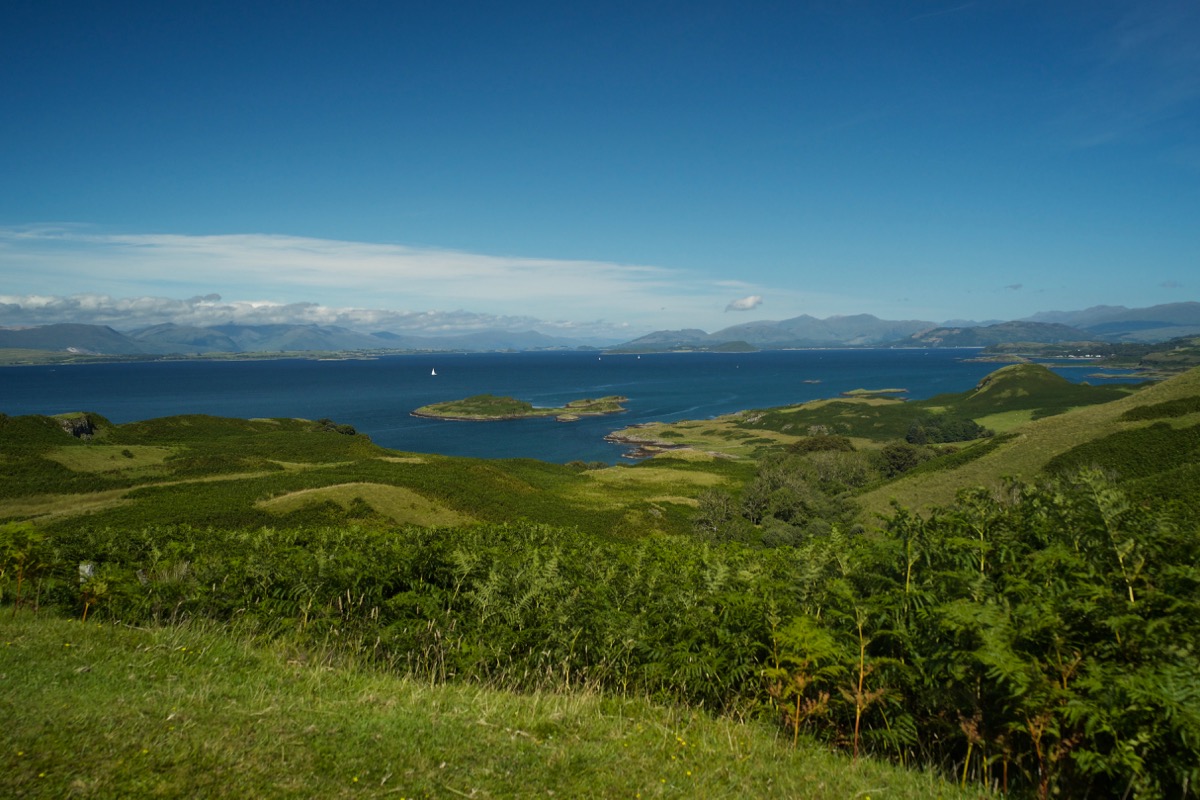
Reference:
- Historic Environment Scotland
- Canmore
- Canmore – detail of oriel window (drawing)
- Mary McGrigor, Argyll: Land of Blood and Beauty (2013)
- Dunollie Castle: The Brooch of Lorn
- Am Baile: The Brooch of Lorn
- National Museums of Scotland
- Colin S MacDonald – Robert the Bruce and the Battle of Dalrigh
- Clan MacDougall Society of North America
- Archaeologia Scotica, Journals of the Society of Antiquaries of Scotland (Vol. IV, 1857)
- WalkHighlands
With many thanks to the MacDougall of Dunollie Preservation Trust for allowing me to include a photo of the replica Brooch of Lorn. All other photos © Colin & Jo Woolf



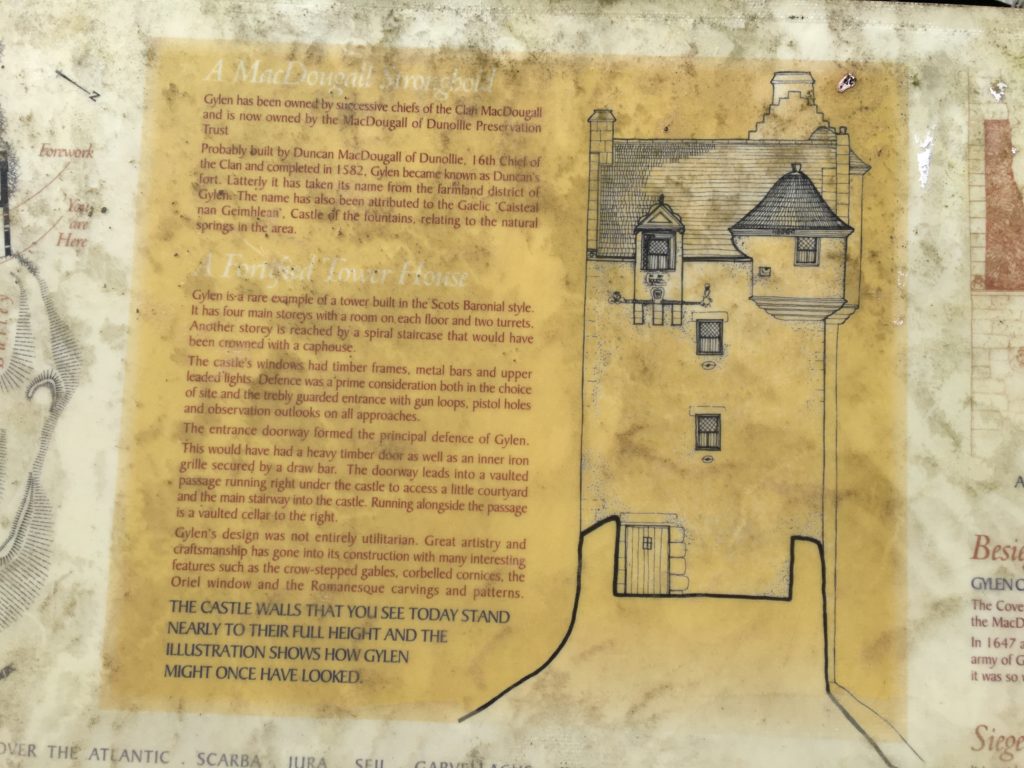
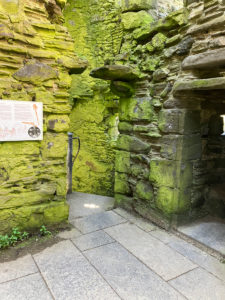
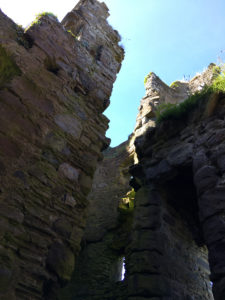
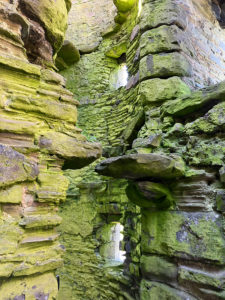
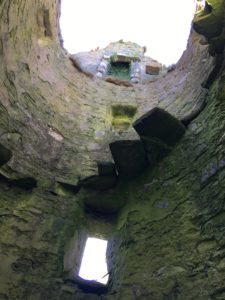
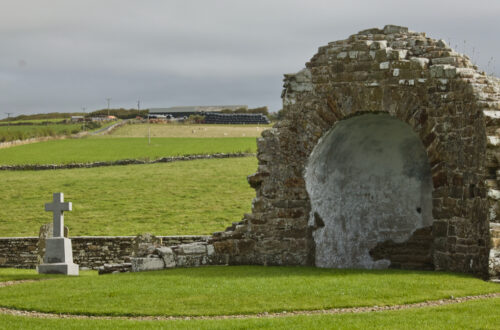
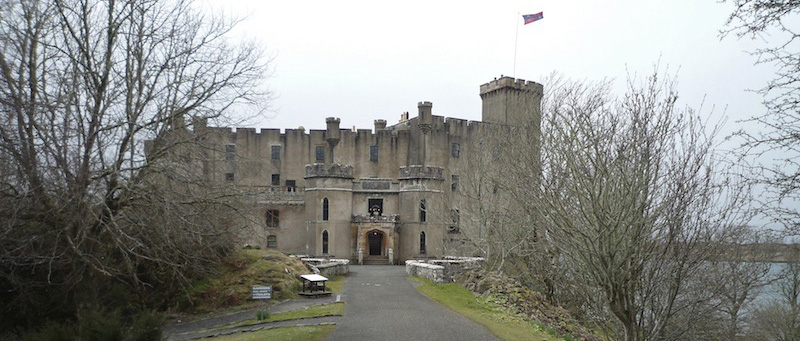
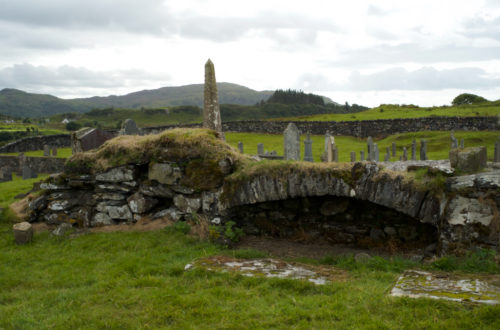
14 Comments
Kenny Crawford
Used to love your posts when I lived in Glasgow and yearned for some fresh air and green spaces.
Still love them after I moved to Oban – because I’ve either been to or can easily visit the places you talk about.
Thanks.
Jo Woolf
Thank you, Kenny, and I’m so glad you’re still enjoying the posts!
Richard Miles
Hi Jo, Thank for writing an interesting and very atmospheric piece.I love those Scottish castles often sited in very remote places like the one you describe.My mum who was a McCallum used to say that the McCallum/Malcolm’s clan castle is still lived in,I would love to reclaim it,but I’m half English ,so I don’t think I would get very far.
You mentioned some time ago about researching a book on British rain forests.As a retired arborist I am very interested in the subject especially as I live next to Dartmoor with remnants of those and of course Scotland and Wales have good examples of them as well.
I look forward to your next blog.
Kindest regards. Richard Miles
Jo Woolf
Thank you, Richard! I love these old castles too, especially ones that are hard to get to and little-visited. I’m guessing you mean Duntrune, in which case yes, it’s still lived in, so I think you’d have to present a very good case! We sometimes go and walk around the walled garden, which is beautiful, or else you can go straight on and follow the coast around a quiet bay called ‘The Bay of the Tears’, looking across to Crinan. Britain’s rainforests – I’m trying to remember – maybe I mentioned that I was writing about one example (Wistman’s Wood) for my new book, Landmarks and Legends. I have recently been reading a book by Guy Shrubsole, called ‘The Lost Rainforests of Britain’, which you may already have, but if not it might interest you. He lives in Devon and describes his many visits to woodlands there, as well as in Scotland and Wales. We do certainly have some fabulous examples of old woodland around here, with Ballachuan hazel wood and the oak woods of Taynish probably the best known. However, I think a lot of places in Knapdale, Kintyre, and the hills around Kilmartin and further north do have fragments of what looks like old woodland, with hazels, willows, birches and sessile oaks. We were in Glasdrum Woods the other day, which are on the shore of Loch Creran, near Appin – again, a lovely piece of old woodland where we heard and saw wood warblers, and Colin managed to find chequered skipper butterflies, apparently only found in this part of Scotland! With best wishes, Jo
Richard Miles
Thanks again Joe,you certainly live in a beautiful and interesting area ,so much to see ,enjoy and write about.As your book comes out on my birthday,I have dropped a few hints to the family.I know Wistmans wood well,slightly strange that the oaks are pedunculate and not sessile.Richard
Jo Woolf
Maybe one of Oliver Rackham’s books would shed some light on how many pedunculate oak woods are left in comparison to sessile. It’s an interesting thought. What a nice coincidence that the book comes out on your birthday! 😀
Bob Hay
Hi Jo. Interesting article as alway. Re ‘rain forests’. I walked through a vast rain forest on Vancouver Island in Canada a few years ago. Giant moss covered trees absolutely dripping with moisture and fungii everywhere, like a scene from Jurassic Park. Is this the way you visualise Scotland’s?
Re the Brooch of Lorne supposedly belonging to Bruce. Maybe have it displayed in the National Museum with ‘Wallace’s’ sword, also of dubious origin.
Maybe you could do a article on the MacLeod’s Fairy Flag or Rory Mhor’s drinking horn.
Jo Woolf
Thank you, Bob. That forest in Vancouver sounds amazing! I don’t know if I imagine a Jurassic-type scene in our woodlands here, it’s more a completeness of nature but it seems quite timeless if that makes any sense! I didn’t know that there was controversy about Wallace’s sword – I haven’t seen it, because I’ve not visited the Wallace monument. The Fairy Flag – yes, I remember seeing this when we visited Dunvegan about 10 years ago, and being amazed at the stories. I did write a blog post but it’s pretty old! https://thehazeltree.co.uk/2013/08/07/the-fairy-flag-of-dunvegan/ I can remember less about the drinking horn, which must have been on display in the castle too. There were artefacts relating to the ‘Bonnie Prince’, and I also remember looking through a grille to a dungeon which was set into the floor of one of the reception rooms, from which a mannequin dressed as a prisoner was omitting occasional groans. Talking about the horn of Rory Mhor, there was a programme (repeat) on York, in the series on Britain’s Historic Towns, where they looked at the ‘oliphant’, an elephant’s horn presented by a Norse nobleman to York Minster. I saw this more recently on a visit to York – what an amazing thing!
Bob Hay.
Re Wallace’s sword Jo. Looking into its ‘parts’ reveal it could be like one of those faithful old axes that have lasted many many decades and which have only had the head replaced four times and the handle ten.
Re the Fairy Flag (Hope I’m not going to far off Thread here). I think the Harald Hadrada connection more plausible and Godred Crovan gets well mentioned in Tim Clarkson’s latest book, ‘A Mighty Fleet and the King’s Power’.
Jo Woolf
That’s interesting re. the Fairy Flag – will make a note to get Tim’s book! Such a vivid picture, to imagine it being flown as a Viking flag. Regarding the sword, I can remember reading something recently, about a philosophical argument involving old artefacts that have been repaired and at what stage do they stop being original!
davidoakesimages
Hi Jo, That brought back memories. Our first visit to Kerrera was so long ago I cannot put a true date on it. All I know we had our 3 kids with us when they were relatively small. We came stumbled across the ferry by accident… and in those days it was just a rowing boat with outboard. A spur of the moment decision. We landed and just headed off following a track on the shore side of the isl;and. Turning a corner and suddenly seeing the castle was an unexpected surprise. What a location. So good it was time to sit and take in the view and enjoy our lunch…. a lunch that was also graced by a curious Otter. Been back several times to do the circular walk, always magic but sadly no repeat view of Otters. (maybe because the island is busier now). One amusing trip back was when the ferry also brought back some sheep from the island…. one of the guys shepherding the sheep took a fancy to our dog, was persistent and actually offered us money to sell her. he was serious, we were equally as serious and Trixie continued her holiday safely with us. Memories 🙂
Jo Woolf
Oh wow, that sounds like a very memorable trip! You were lucky to visit it at that time, and seeing an otter is just magical. I think you just have to be lucky, in the right place at the right time – we see them fairly often here, and sometimes there have been people around so they don’t seem to be discouraged. Kerrera’s lack of roads must help enormously towards retaining its peace and charm. It’s a lovely feeling, when the ferry leaves you there for the day! I expect Trixie was glad to go home with you! She must have had untapped potential as a sheepdog!
Finola
Fascinated by the details of the tower house. That oriel window is so unique and it’s amazing that it’s so intact. I wanted the brooch to be 14th c so badly.
Jo Woolf
I guess the window has survived pretty well considering the treatment it’s had! I would love to know who the woman is, in the carving. I know, the brooch has such a wonderful story, and it’s hard to hear that the dates don’t match. Maybe it’s just the setting, being remodelled!